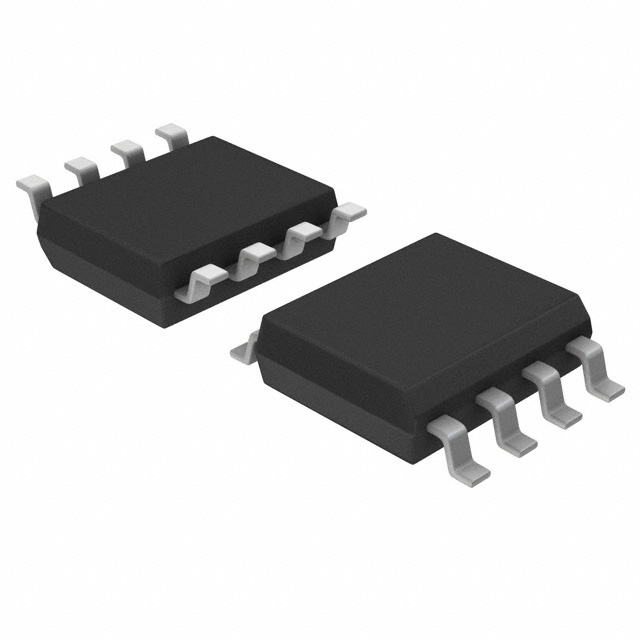DS485TM
Product Overview
Category: Integrated Circuit (IC)
Use: DS485TM is a high-speed differential bus transceiver designed for bidirectional data communication over long distances. It is commonly used in industrial automation, building automation, and other applications that require reliable and noise-immune data transmission.
Characteristics: - High-speed data transmission - Differential signaling for noise immunity - Low power consumption - Wide operating voltage range - Robust ESD protection
Package: DS485TM is available in a compact 8-pin SOIC package, which ensures easy integration into various electronic systems.
Essence: The essence of DS485TM lies in its ability to provide a reliable and efficient means of transmitting data over long distances while minimizing the impact of noise and interference.
Packaging/Quantity: DS485TM is typically sold in reels containing 250 units per reel.
Specifications
- Supply Voltage Range: 4.5V to 5.5V
- Data Rate: Up to 10 Mbps
- Operating Temperature Range: -40°C to +85°C
- Input Hysteresis: 50 mV
- Output Current: ±60 mA
- ESD Protection: ±15 kV (Human Body Model)
Detailed Pin Configuration
- DE (Driver Enable)
- A (Non-Inverting Data Line)
- B (Inverting Data Line)
- GND (Ground)
- VCC (Supply Voltage)
- Y (Receiver Output)
- Z (Receiver Output)
- RE (Receiver Enable)
Functional Features
- Bidirectional data transmission
- Driver enable control for bus arbitration
- Receiver enable control for low-power standby mode
- Built-in fail-safe biasing resistors for open-circuit conditions
- Thermal shutdown protection
Advantages and Disadvantages
Advantages: - High-speed data transmission capability - Excellent noise immunity due to differential signaling - Low power consumption for energy-efficient operation - Wide operating voltage range for compatibility with various systems - Robust ESD protection for enhanced reliability
Disadvantages: - Limited maximum data rate compared to some other high-speed transceivers - Requires careful consideration of termination and bus topology for optimal performance
Working Principles
DS485TM utilizes differential signaling, where data is transmitted as the voltage difference between two lines (A and B). This method allows the receiver to distinguish between valid data and common-mode noise. The driver and receiver sections are controlled by DE and RE pins, respectively, enabling bidirectional communication.
Detailed Application Field Plans
DS485TM finds extensive use in various industrial automation applications, such as: - Supervisory Control and Data Acquisition (SCADA) systems - Programmable Logic Controllers (PLCs) - Remote Terminal Units (RTUs) - Motor control systems - Building automation systems
Its robustness against noise and long-distance transmission capabilities make it suitable for environments with electromagnetic interference and where reliable communication over extended distances is required.
Detailed and Complete Alternative Models
- SN75176 - A similar differential bus transceiver with comparable specifications and features.
- MAX485 - Another popular choice for differential bus communication, offering similar functionality and performance.
- LTC2850 - A high-speed differential transceiver with advanced features like hot-swappable capability and low quiescent current.
These alternative models can be considered based on specific application requirements and system compatibility.
Word count: 511 words
قم بإدراج 10 أسئلة وإجابات شائعة تتعلق بتطبيق DS485TM في الحلول التقنية
What is DS485TM?
- DS485TM is a high-speed differential bus transceiver designed for balanced data transmission over twisted-pair cabling.
What are the key features of DS485TM?
- The key features of DS485TM include high data rates, low power consumption, and robust noise immunity.
How is DS485TM different from other transceivers?
- DS485TM offers improved noise immunity and higher data rates compared to traditional transceivers.
What are the typical applications of DS485TM?
- DS485TM is commonly used in industrial automation, building automation, and automotive applications for reliable data communication.
Can DS485TM be used in harsh environments?
- Yes, DS485TM is designed to operate in harsh industrial environments with wide temperature ranges and high electromagnetic interference.
What is the maximum data rate supported by DS485TM?
- DS485TM supports data rates up to 10 Mbps, making it suitable for high-speed communication requirements.
Does DS485TM support multi-point or daisy-chain topologies?
- Yes, DS485TM supports both multi-point and daisy-chain topologies, providing flexibility in network design.
What are the power supply requirements for DS485TM?
- DS485TM typically operates from a single 5V supply, making it compatible with standard industrial power systems.
Is DS485TM compatible with existing RS-485 networks?
- Yes, DS485TM is fully compatible with existing RS-485 networks, allowing for easy integration into current systems.
Are there any application notes or reference designs available for DS485TM?
- Yes, application notes and reference designs for DS485TM are available to assist with implementation in technical solutions.


